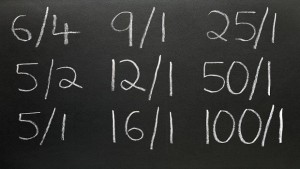Fourfold Bet Meaning
- Looking to get your head around four fold betting? Searching for ways to improve your four fold bets? Check out our guide! Read more at OpenOdds.
- What is an accumulator bet? Learn all about accumulator bets, how they work and how to calculate returns on your winning bets.
- We very much hope you were on the week 31 Tips as we nailed the CLEAN-SWEEP!!! Double, Treble & Four-fold all landing meaning even more.
< Return to what is a trebleGo to what is a trixie >
Why do bookmakers use the term Secure Bet in sports betting? How to understand what is the meaning of the word Secure Bet? Secure Bet explained. Goal line betting is common in football betting, particularly with the popular over/under 2.5 goals option. But what about placing an alternative goal line wager or an Asian Goal Line bet, how do.
·An 'Accumulator' bet involves more than one selection on a bet, often consisting of four or more selections, which basically requires all selections to win. The stake and return from the first selection rolls on to the next, until the final selection on the bet is settled. Of course, a losing selection result in the accumulator reults in the bet being settled as a losing bet.
An accumulator bet is one of the most popular and well-known forms of multiple bets available. It is particularly common in football, where it is used by bettors to bet on a range of matches across one or several leagues. It is often referred to as an 'acca'.
The minimum number of games that can be bet upon in an accumulator is four, but many more are available. Yankees and Lucky 15s, for example, are forms of accumulators that allow bets to be placed on 11 or 15 events respectively. Two and three-fold accumulator bets can be placed, but these types are not commonly called accumulators. While they follow similar rules to accumulators, they are instead referred to as doubles and trebles respectively.
As there are so many matches involved, accumulator bets are a great way for bettors to make high returns for a relatively low stake. However, it is important for anyone placing an accumulator bet to have a detailed knowledge on the sport and the participants they are betting on. While stakes are low, risks are high as just one lost bet could result in the entire accumulator losing. Clear insight is therefore important if bettors are to avoid losing their stake.
Accumulator bets
The attractive element of accumulator bets is that their odds are calculated in a very different way to traditional odds. Accumulator bets bundle the odds together to create greater value for the person betting. There are two potential ways to explain the way this is done. Sometimes the maths of an accumulator bet is described by increasing the odds of the participants being bet upon and then multiplying them together.
This means that if a four-fold accumulator were being placed on four horses and those four horses were given odds of 2/1, 3/1, 2/1 and 4/1, the odds would increase to 3/1, 4/1, 3/1 and 5/1 respectively. These numbers would then be multiplied to produce a figure of 180. In this scenario, the odds would be 179/1 as 179+1=180.
A second, and somewhat clearer, way also exists. In this methodology, the return from each bet is essentially rolled over onto the next bet. In the example previously given, a £2 stake on the first bet (at 2/1) would return £6 (£4 and the original £2 stake). This £6 would then be used as the stake for the second bet and the return from that used on the third bet and so on. While these two descriptions sound very different, the idea is essentially the same: accumulator bets are, as the name suggests, cumulative bets that grow in value with each additional bet.
Applying this to a real-world example, it's easy to see how an accumulator can reap very high rewards for bettors. In this scenario, the person is placing a six-fold accumulator, meaning that they are placing six bets. These bets are:
1) Manchester United to beat Newcastle United at 2/1

2) Arsenal to beat Tottenham Hotspur at 2/1
3) Liverpool to beat Leicester City at 4/1
4) Chelsea to beat Bournemouth at 3/1
5) Manchester City to beat West Ham United at 3/1
6) Wolverhampton Wanderers to beat Cardiff City at 4/1
The bettor puts down a £2 stake and all the bets win. The first bet wins £6 (£4 plus the original £2 stake).
This money is then placed on the second bet and that returns £18 (£12 plus the £6 stake).
£18 is then put as the stake for the third bet, earning £90 (£72 plus the £18 stake).
The fourth bet is therefore a £90 stake, creating a £360 return (£270 plus the £90 stake).
The fifth bet is a £360 stake, creating a return of £1,440 (£1,080 plus the £360 stake).
Finally, that £1,440 is staked on the final bet, and this makes for a final return of £7,200 (£5,760 plus the £1,440 stake).
It's clear to see how the winnings on an accumulator differ greatly from the winnings that would be made from six £2 single bets. In this scenario, the bettor would make just £48 (plus the original £2 stake) as the winnings from the prior bet are not being rolled over and used on the next one.
Accumulators are available for a wide range of sports, including the likes of greyhound racing and horse racing. However, they can not be placed on one single event. They must be placed across a range of different matches or races.
Different kinds of accumulators
As mentioned, there are a number of different accumulator bets that are available to bettors.
A double bet is comprised of only two selections. If both selections win, then the bet is won. If not, it is lost.
A treble bet adds another selection to the double bet and follows the same rules. If all three selections win, then the bet is won. If they do not win, then the bet is lost.
A trixie bet is somewhat similar to a treble bet in that the bettor makes three selections. However, in this kind of a bet, there are four bets being made: three double bets and one treble bet. The advantage of a trixie bet is that even if one selection loses and the treble bet fails, there is still the chance that one of the double bets will win and some kind of a return will be secured.
A yankee bet is an accumulator consisting of 11 bets. There are a number of different kinds of bets within this group: a single four-pronged accumulator, alongside six doubles and four trebles. This means that even if some of the participants in the accumulator do not win, there is still a good chance that one of the bets will win and a return of some form will be earned.
Finally, there are Lucky 15 bets which, as the title suggests, is a 15-fold accumulator. This kind of a bet is made up of four singles, six doubles, four trebles and one four-fold accumulator. This means that the chances of a return are even higher, and there is the added benefit of the bonuses that many bookmakers offer for certain outcomes. These bonuses are the reason the Lucky 15 has its name.
Accumulators are difficult to win but can result in very high returns for very low stakes. Bettors who feel that they are well versed in the sport they are betting on and the participants who are competing can stand to significantly benefit from a well-chosen accumulator.
Plus, don't forget to check out our bet calculator, where you can calculate your winnings.


< Return to what is a trebleGo to what is a trixie >
I turn on the TV and see commercial after commercial promoting online-casinos and gambling. With all-time low interest rates here in Sweden, the gambling business is flourishing. I see a woman sitting at a kitchen table, a look of despair on her face as she looks at unpaid bills. In the next scene she buys a lottery ticket, expression turns blissful. Last scene – she is flaunting money all around. It is like seeing a typical reverie from people who are bad at assessing risk.
We are constantly at the mercy of risk, a fact which businesses and people are eager to make money from. Have you ever thought about buying life insurance? Mathematicians employed by insurance companies have created models that calculate the probability of you dying using statistical data. Factors that are taken into account are for example your gender and age. This will affect the insurance you can receive relative to the premium you will have to pay, so that it benefits the insurance company.
What Is 4 Fold Bet
When you apply for a bank loan, the bank will calculate the probability of you defaulting on the loan and give you an appropriate interest rate to account for this risk so that the bank still profits. When you buy lottery tickets the game is mathematically rigged against you. The price you have to pay for the ticket, the probability of you winning and the amount you can win is not adjusted in your favor. Businesses and people that master the art of rationally assessing risk will make better decisions and in the long run make huge profits.
But how do you rationally assess risk? Risk assessment is the overall process of identifying and analyzing risk, think risk vs. reward. As we touched on the subject of gambling, Let’s take Texas Hold’em poker for example, a great way of training risk assessment skills and even taught at MIT.
Fourfold Bet Meaning

Your hand is the 7,8 of diamonds and you are at the turn, meaning the dealer has dealt four cards and only one more card will be dealt after you and your opponent have finished betting.
The pot is 200$ (the money you and your opponent are trying to win). Your opponent goes all-in with 500$, making the pot 700$. You only have two choices, either put 500$ into the pot as well and show your cards; one more card will then be dealt and the best hand will win the 1200$ pot. The other choice is that you fold, meaning that you give up and let the opponent take the pot. What should you do?
If you “call” the 500$ and get to see the last card, the only reasonable way you can win is if you get a straight, meaning either a 5 or 10 will be dealt on the “river” (right now you only have 8-high, meaning you would even lose to many total bluffs from your opponent). The probability of a 5 or 10 being dealt from this position is:
(there are eight cards in the deck that make you win. there are 52 cards in a deck and two of those are visible in your hand, leaving 50. In addition, there are four cards exposed that every player can see, leaving 46 cards.)
But we cannot just account for the probability of winning, but the amount we can win and the price we have to pay for it.
There is 700$ in the pot so 120$ is a rational amount to pay in order to win the pot (0.17 × 700 ≈ 120$), this will make you break even in the long run. If you had to pay say 70$ to win the 700$, you would make a great deal and make more money in the long run. The thing is your opponent is forcing you to pay 500$ in order to see the last card, giving you horrible value for your money. You make the rational decision and quickly fold because you are not mindless gambler.
Being able to assess risk is a crucial part of life and very important when working with information security. A popular quantitative method for assessing risk in information security is calculating the annual loss expectancy (ALE).
Let’s imagine that online-gambling websites in Sweden are starting to suffer DDoS-attacks in an attempt from hacktivists to disrupt their operations. Their management asks you (now working as a security consultant) what to do. You say that they need to purchase a new cloud-based web application firewall (WAF) from a well-established vendor. It will cost 7000$ each year. They say it is too expensive. After having performed a risk assessment, you say that the new WAF will actually help them save money. This is why:
From historical data it was made clear that they suffered one successful DDoS attack every two years. Meaning they have 50% chance of a successful DDoS-attack occurring yearly. The average cost of one attack was measured to 20.000$. The new WAF would reduce the chance of a successful DDoS to 5% each year.
(1) Annual loss expectancy (ALE) without the WAF: 0.5 x 20.000 = 10.000$
(2) Annual loss expectancy (ALE) with the WAF: 0.05 x 20.000 + 7000 = 8000$
After showing the management this data, they realized that they would actually save 2000$ each year from implementing the WAF and became more enthusiastic.
Companies need to understand that security is not just painful costs in order to comply with regulation. It is there to mitigate risk, which could even help them save money in certain cases. If the ALE would be higher with the WAF, say 12000$ instead 8000$, I would not recommend using the WAF as they would lose more money each year.
A risk assessment is about knowing when to bet and when to “fold”, so you do smart investments and avoid dumb ones.